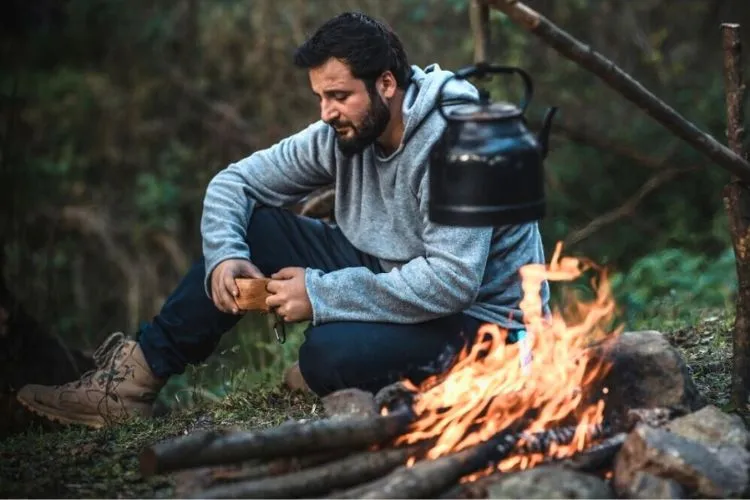Venturing into the great outdoors demands respect for nature and an understanding of essential survival skills.
One fundamental concept is the “Survival Rule of Fours“.
This guideline equips individuals with the knowledge to prioritize survival needs effectively. While primarily relevant to wilderness survival, the Rule of Fours also offers insights applicable in urban survival situations.

What Is Survival Rule Of Fours?
At its core, the Survival Rule of Fours revolves around four basic human survival needs: air, shelter, water, and food.
Understanding and managing these needs is crucial in any emergency situation. The rule outlines a simple yet powerful timeframe for prioritizing these needs:
- You can survive approximately four minutes without air.
- Harsh conditions necessitate finding shelter within four hours.
- The human body needs water at least every four days.
- Approximately, one can go four weeks without food.
These timeframes are not absolute but serve as a guiding principle to manage survival priorities effectively.
Air: The First Priority
Oxygen is essential for life. The human body suffers severe consequences without adequate air supply within minutes. Air quality becomes a significant concern in situations involving fires, chemical spills, or confined spaces. Thus, ensuring access to clean air is paramount.

In survival scenarios, focusing on breathing calmly conserves oxygen. Techniques like slow, deep breaths can help manage panic and maintain oxygen efficiency. If faced with smoke or harmful fumes, finding ways to filter air, using clothing or improvised masks, can provide temporary relief.
Shelter: Protection from the Elements
After securing a breathable environment, the next priority is shelter. Environmental hazards, including extreme temperatures, precipitation, and wind, demand immediate attention.
A shelter serves as a protective barrier against these elements, providing a safe space to maintain body temperature and avoid hypothermia or heatstroke.

Constructing a shelter requires resourcefulness, utilizing natural or man-made materials available. In forests, debris or branches can form the basis of a shelter. In urban environments, abandoned buildings or vehicles may offer temporary refuge.
The type of shelter depends on the environment, available resources, and the immediate threat posed by the elements.
Water: Sustaining Life
Water is the essence of life. The body’s need for hydration becomes critical within days. Dehydration impairs bodily functions, affecting mental and physical performance. Thus, finding a clean water source is a survival priority.

Natural sources like streams, lakes, and rain offer potential water supplies. However, purification is necessary to avoid contaminants. Boiling, chemical purification, and filtration are effective methods to ensure water safety. Carrying purification tools or knowing how to create makeshift filters increases survival odds.
Food: The Final Concern
Food sustains energy levels and supports physical strength, but it ranks last in the Survival Rule of Fours. The body can survive weeks without food, utilizing fat reserves for energy.
However, prolonged lack of nutrition leads to muscle loss and weakened physical condition.

Foraging for food requires knowledge of edible plants and the ability to trap or hunt small animals. Safety is paramount, as some plants and animals might be toxic. Learning basic foraging skills before an outdoor adventure can make a significant difference in a survival situation.
Prioritizing Needs Based on Environment and Circumstance
The Survival Rule of Fours serves as a general guideline. However, actual priorities may change based on specific environments and circumstances. For instance, in a desert, finding water might become an immediate concern, overshadowing the need for shelter. Adapting to the situation is key to survival.
Understanding local climates, geography, and potential hazards prepares individuals to prioritize effectively. Flexibility and the ability to reassess priorities as conditions change are critical survival skills.
Enhancing Survival Odds with Preparation
Preparation is the foundation of survival. Familiarity with the Survival Rule of Fours, combined with practical survival skills, significantly improves the chances of enduring emergencies. Essential items like a knife, waterproof matches, a water purification device, and a compact emergency shelter should be staples in any survival kit.
Survival kits tailored to specific environments enhance preparedness. Whether embarking on a wilderness hike or preparing for urban disasters, the right tools and knowledge are vital.
Survival Myths and Misconceptions
Understanding what to do in a survival situation can simply be a matter of life or death, but unfortunately, misinformation and prevalent survival myths can lead individuals astray. One common misconception is that you should suck the venom out of a snakebite.

In reality, trying to suck out venom can cause harm and contamination, leading to more complications. Instead, one should stay calm, limit movement, and seek immediate medical help. Another myth suggests that moss only grows on the north side of trees.
Moss growth, in fact, can be influenced by various environmental factors and should not be relied upon for navigation. Consuming snow for hydration is another mistake. It may lower your body temperature, leading to hypothermia. Instead, melt it first.
It’s crucial to gather survival information from reliable sources and undergo appropriate training to avoid such misconceptions that can jeopardize survival.
Frequently Asked Questions (fAQs)
What’s the difference between the Survival Rule of Threes and Fours?
The Survival Rule of Threes and Fours share the same survival priorities but differ in their timeframes. The Rule of Threes suggests slightly shorter survival timeframes without air, shelter, water, and food. Both rules provide a framework for prioritizing survival needs, emphasizing the importance of air, shelter, water, and food in sustaining life.
How realistic are the Rule of Fours in actual survival situations?
The Rule of Fours, like any guideline, serves as a general principle rather than a strict rule. Survival situations vary greatly based on individual health, environment, and specific circumstances. These rules offer a foundational understanding of priorities but must be adapted to real-life situations.
Can the Survival Rule of Fours apply in urban survival scenarios?
Yes, the Survival Rule of Fours applies to both wilderness and urban survival scenarios. While the source of threats might differ, the fundamental needs for air, shelter, water, and food remain consistent. Adapting these principles to the urban environment involves recognizing available resources and hazards specific to urban settings.
Conclusion
The Survival Rule of Fours is a fundamental survival concept that prioritizes the basic human needs of air, shelter, water, and food. This guideline serves as a starting point for managing survival situations.
However, adaptability, preparation, and a practical understanding of survival techniques are crucial for overcoming emergencies. Remember, knowledge is power, but preparation ensures readiness for whatever challenges nature or unexpected situations may present.


